Autonomous Data-Trust Monitor with ML
Upstream Data Trust Monitor minimizes unknown errors downstream
Data errors get amplified as it flows downstream through the data pipeline

In spite of investing in DQ and Observability tools, due to a lack of trust in data:
- 40% failure of data initiatives
- 20% drop in labor productivity
What is Trustability?
Data Trustability is sought by Catalog teams and Data Management teams.
- Data Profile
- Objective Data Trust Score (DTS) for every DQ dimension with AI/ML
- Aggregate DTS
Trustability throughout the Data Pipeline
- Data fingerprint
- Self-learning
- Dynamically evolves
- Known-known errors
- Unknown-unknowns
- Objective Data Trust Score
Challenge with existing non-ML tools to determine Trustability Challenges with Traditional Approach
Knowledge Gap
Many times, data quality analysts are unfamiliar with the data assets obtained from a third party, either in a public or private context. They need to engage with subject matter experts extensively in order to build data quality criteria.
In a Snowflake Data Cloud, as organizations share datasets with each other, data quality analysts may not have access to subject matter experts from another organization.
Processing Time
Time to Use the Dataset: Even if you are intimately familiar with the dataset, it can take between 2 to 5 business days to analyze the data quality.
Snowflake Data Cloud reduces the data exchange time drastically. However, adding additional days to manually perform the data quality adds to the timeline and defeats the purpose.

Why is it Important to Use a Machine Learning based Approach
Machine Learning is known for solving complex problems and executing results faster than intended without any human error.
Using ML in Snowflake Data cloud has some advantages:
- Machine Learning helps to objectively determine data patterns or data fingerprints, and translate those patterns to data quality rules.
- Machine Learning can then use the data fingerprints to detect transactions that do not adhere to the rules.
- Implementing an ML approach can help to quickly assess the data health check
ML is usually more comprehensive and accurate than a human-driven data quality analysis.

Powered by ML, DataBuck continuously monitors Data Trustability across the entire data pipeline. It validates Trust from the Data Lake to Data Consumption (L2C)

Platforms Supported by DataBuck
Data Lake
AWS
AZURE
GCP
Data Warehouse
Snowflake
Redshift
Biqquery
Cosmos
Postgres
Data Pipeline
Glue
Airflow
DataBricks
DataFlow
Autonomous Data Trust Score With DataBuck
See how DataBuck Leverages AI/ML for Superior Data Quality
Understand Data Trustability Read our blogs
What Data Sources Can DataBuck Work With:
DataBuck can accept data from all major data sources, including Hadoop, Cloudera, Hortonworks, MapR, HBase, Hive, MongoDB, Cassandra, Datastax, HP Vertica, Teradata, Oracle, MySQL, MS SQL, SAP, Amazon AWS, MS Azure, and more.

